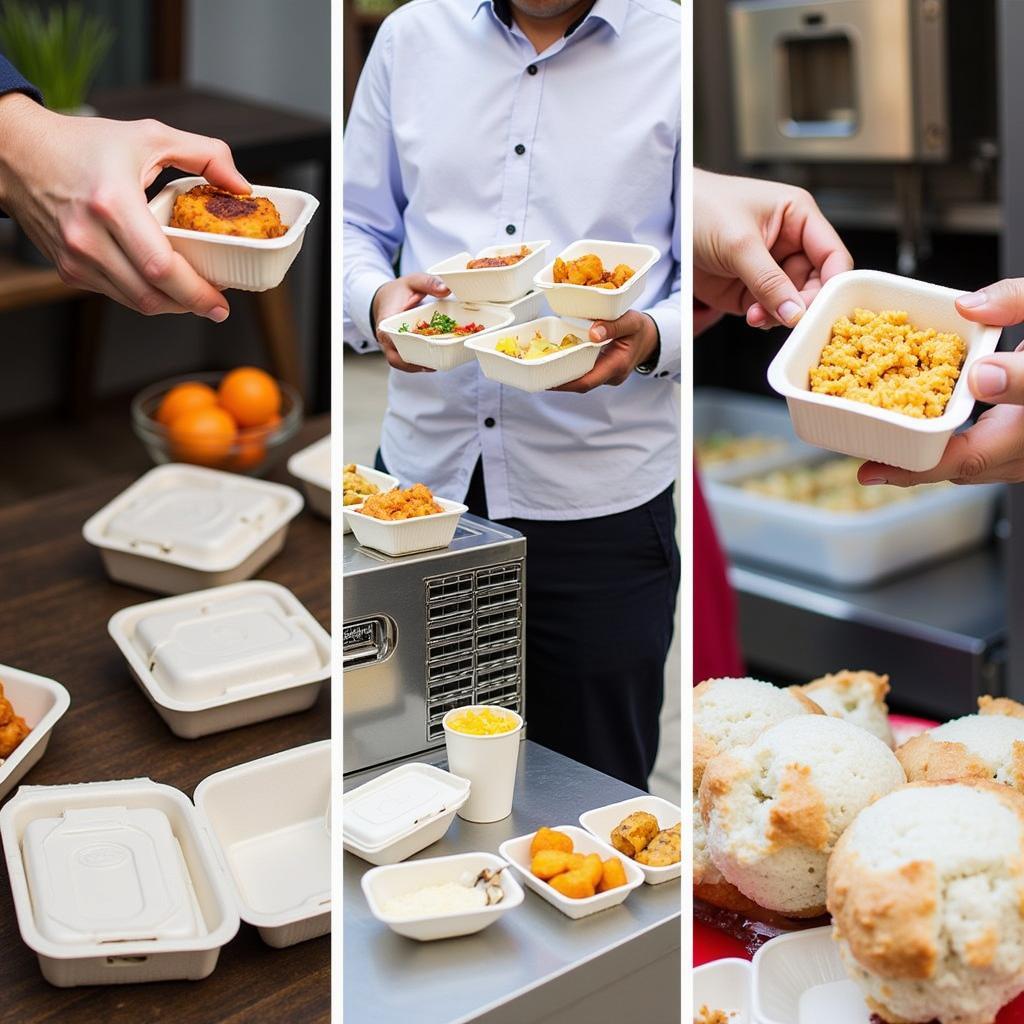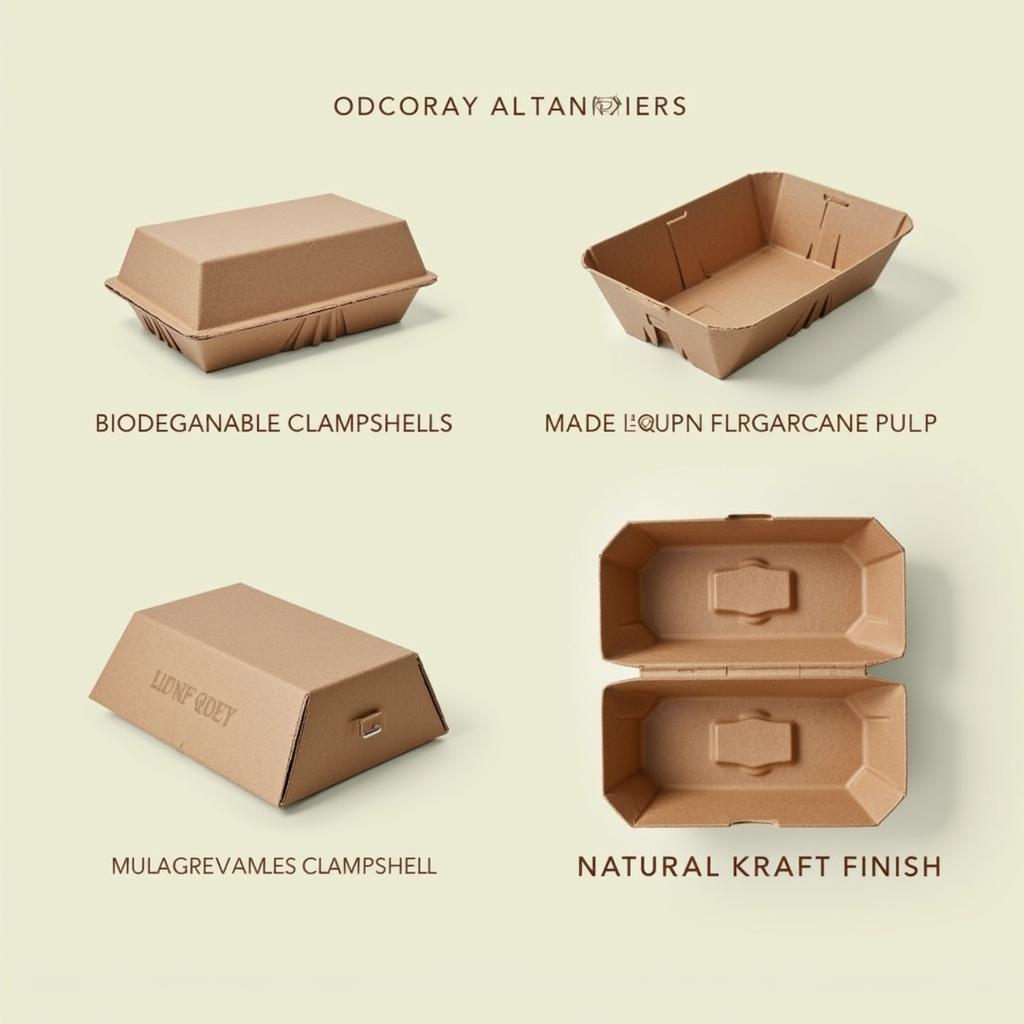Clamshell Food Containers have become a ubiquitous sight in our takeout-driven world. These convenient containers, named for their hinged, clamshell-like design, offer a practical and efficient way to package and transport food. But what exactly are clamshell food containers made of, and what are their benefits and drawbacks? Let’s delve into the world of clamshell food containers and explore their impact on our food experiences.
Understanding Clamshell Food Containers: Materials and Uses
Clamshell food containers are typically made from a variety of materials, each with its own set of properties:
- Plastic: This is the most common material for clamshells due to its lightweight nature, durability, and affordability.
- Biodegradable Plastic: As environmental concerns rise, biodegradable plastic options derived from plant-based sources are gaining popularity.
- Cardboard: Offering a more eco-friendly choice, cardboard clamshells are often used for hot food items.
Clamshell containers find their way into various food businesses:
- Restaurants: From salads to sandwiches, clamshells keep food fresh and secure for takeout and delivery orders.
- Food Trucks and Stalls: Their compact size and easy stacking make them perfect for on-the-go meals.
- Cafeterias and Catering: Serving large groups becomes more manageable with clamshells, ensuring portion control and easy distribution.
 Clamshell Food Containers Used in Different Food Settings
Clamshell Food Containers Used in Different Food Settings
Advantages of Using Clamshell Food Containers
The popularity of clamshell containers stems from their numerous advantages:
- Convenience: Their hinged design allows for easy opening and closing, making them user-friendly for both businesses and consumers.
- Portion Control: Clamshells come in various sizes, facilitating accurate portioning and minimizing food waste.
- Stackability: Their shape allows for efficient stacking, saving valuable storage space in kitchens and refrigerators.
- Leak Resistance: Most clamshell designs include a secure locking mechanism to prevent spills and leaks during transport.
- Visibility: Clear plastic options offer excellent product visibility, enhancing the appeal of the food inside.
“For our busy lunch rush, clamshells are a lifesaver,” says Chef Michael Thompson of The Daily Grind. “They streamline our packaging process and give our customers a reliable, leak-proof way to enjoy their meals on the go.”
Addressing Environmental Concerns: The Sustainability Factor
While practical, the environmental impact of clamshell containers, especially those made from conventional plastic, is a growing concern. However, the industry is adapting:
- Sustainable Alternatives: Biodegradable plastic and cardboard options offer more environmentally friendly choices.
- Recycling Initiatives: Many areas have implemented recycling programs specifically for clamshell containers.
- Consumer Awareness: Educating consumers about proper disposal and encouraging reusable alternatives play a crucial role.
Choosing the Right Clamshell for Your Needs
Selecting the appropriate clamshell container depends on various factors:
- Food Type: Consider the temperature, texture, and size of the food to determine the best material and size.
- Branding: Custom-printed clamshells offer an opportunity to showcase brand identity and enhance brand visibility.
- Budget: Balance the cost of the containers with your budget, keeping in mind the long-term benefits.
 Sustainable Options for Clamshell Food Containers
Sustainable Options for Clamshell Food Containers
Alternatives to Clamshell Food Containers
While clamshells offer undeniable convenience, exploring alternatives is always a good practice:
- Restaurant Plastic Food Containers: For hot, saucy dishes, these containers provide a sturdier option.
- Cardboard Food Trays: A sustainable choice for quick bites and snacks.
- Fast Food Boxes: Ideal for larger meals and combos, these boxes offer ample space.
- Styrofoam Food Boxes: Known for their insulation properties, these are suitable for both hot and cold food.
FAQs About Clamshell Food Containers
Q: Are all clamshells microwave-safe?
A: Not all clamshells are microwave-safe. It’s crucial to check the label or product description for heating instructions.
Q: Can I wash and reuse clamshell containers?
A: While some clamshells may be labeled as reusable, it’s generally recommended to use them for single-use purposes to maintain food safety and hygiene.
Q: Where can I buy clamshell food containers?
A: Clamshells are widely available from restaurant supply stores, online retailers, and even some supermarkets.
Making Informed Choices for a Sustainable Future
Clamshell food containers offer a practical solution for our fast-paced lives. By understanding the different materials, benefits, and environmental impact of clamshells, we can make informed choices that prioritize convenience while minimizing our ecological footprint. Let’s strive for a world where sustainable practices and delightful food experiences go hand in hand.
Need expert advice on choosing the right food packaging solutions for your business? Contact us at Phone Number: 02437655121, Email: minacones@gmail.com, or visit us at 3PGH+8R9, ĐT70A, thôn Trung, Bắc Từ Liêm, Hà Nội, Việt Nam. Our 24/7 customer support team is always here to assist you.